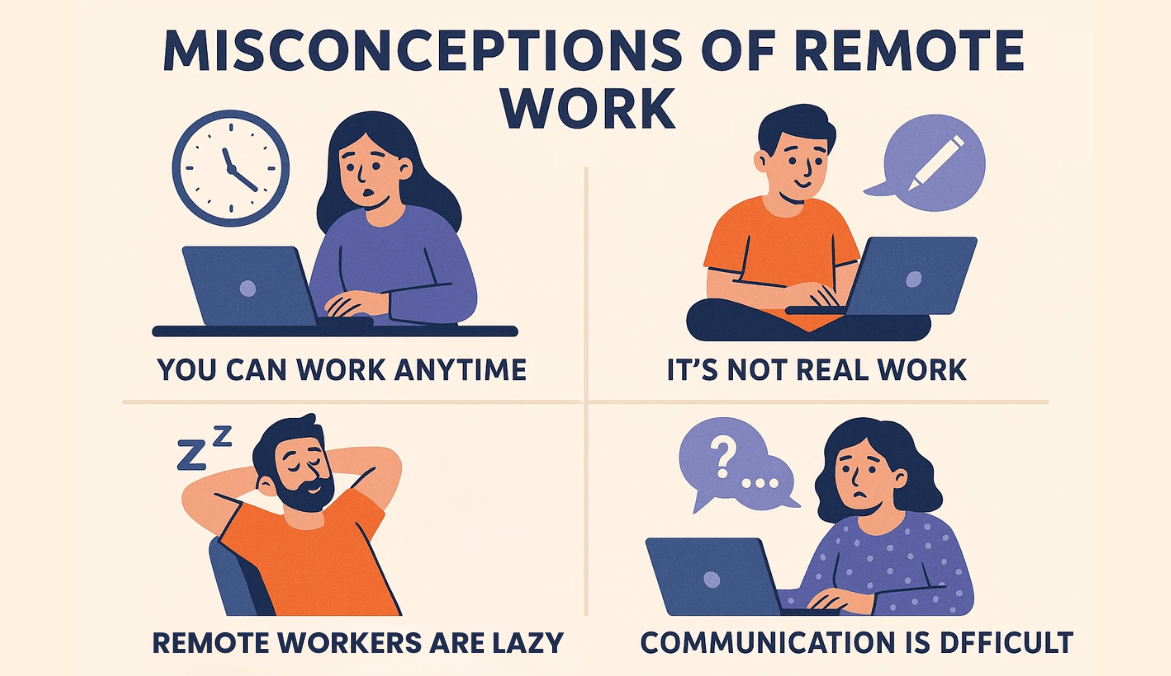Why Remote Work Myths Still Exist in 2025
Every few months, a new headline claims “remote work is dead” or “employees are coming back to offices.” Yet if you look closer, what’s really happening is evolution, not extinction. Teams aren’t rejecting flexibility — they’re redefining it.
Over the years leading distributed tech and cross-functional teams, I’ve seen the same pattern: myths thrive when leaders confuse visibility with control. Remote work doesn’t fail because people are home — it fails when management lacks clarity and trust.
Let’s separate fact from fiction — and explore how to make remote work actually work in 2025.
Myth 1: “Remote Workers Are Less Productive.”
This one’s been around forever — and it’s still wrong. The catch? Productivity depends on clarity, not geography.
When companies track activity without context, people burn out or disengage. The real power lies in combining activity data with outcome insights — exactly what tools like Mera Monitor make possible by turning visibility into clarity, not control.
Actionable Fix:
- Set clear deliverables and deadlines instead of “online hours.”
- Use shared dashboards for transparency.
- Schedule brief weekly syncs to unblock, not to micromanage.
Myth 2: “Creativity and Innovation Die Outside the Office.”
Many leaders believe innovation only happens in rooms filled with sticky notes and caffeine. While in-person collaboration is valuable, innovation isn’t tied to a building.
Actionable Fix:
- Replace “one-hour brainstorms” with 48-hour async idea sprints.
- Use shared boards like Miro or FigJam for async input.
- End with a 20-minute decision huddle to pick top ideas.
Myth 3: “Remote Means Always On.”
Remote work was meant to bring freedom — yet many professionals feel more exhausted at home. The problem isn’t remote work — it’s boundary collapse. Without visible start and end cues, the day just blurs. One IMF analysis shows that working from home three days a week saves roughly five hours weekly — about 10% of total work + commute time.
Actionable Fix:
- Define “core collaboration hours.”
- Block calendar time for deep work.
- Encourage teams to signal focus mode (“Deep work — back at 3”).
Myth 4: “Career Growth Stalls If You’re Not Seen.”
This one hits hard — and it’s half true. Visibility does affect promotions. But “visibility” doesn’t have to mean being in the office.
In my early years managing remote engineers, I watched stellar contributors get overlooked simply because they weren’t in daily standups. Once we introduced written impact logs and transparent promotion rubrics, those same people began leading flagship projects.
Actionable Fix:
- Encourage team members to document achievements weekly.
- Hold quarterly growth reviews instead of annual surprises.
- Rotate meeting leadership to give everyone visibility.
Myth 5: “Hybrid Is Just Remote with Office Perks.”
Hybrid isn’t about splitting time — it’s about intentional presence.
Actionable Fix:
- Define why teams meet in person — planning, brainstorming, onboarding.
- Align office days around purposeful work, not attendance.
- Give autonomy on non-critical days.
Myth 6: “Remote Work Isn’t Secure.”
Security concerns are real — but solvable. With multi-factor authentication, device posture checks, and zero-trust architecture, remote infrastructures are often more secure than traditional networks.
Actionable Fix:
- Enforce MFA and encrypted devices.
- Train employees quarterly on phishing and data handling.
- Review access permissions monthly.
Myth 7: “Remote Destroys Culture.”
Culture doesn’t live in a location — it lives in shared purpose. In distributed teams I’ve led, culture thrived when we built rituals, not rules — weekly “wins and fails,” cross-team coffee chats, and digital shoutouts. Gallup’s latest Global Workplace report indicates fully remote employees are the most engaged 31%.
Actionable Fix:
- Keep one personal check-in in every team meeting.
- Host quarterly virtual offsites.
- Celebrate milestones publicly — even in chat threads.
Myth 8: “Surveillance Equals Productivity.”
Some companies misuse monitoring tools believing they’ll boost accountability — but poor implementation kills trust. When used transparently and with purpose — like in Mera Monitor — monitoring data becomes a coaching and productivity tool, not surveillance.
Actionable Fix:
- Communicate why performance is tracked.
- Share productivity insights openly with teams.
- Reward outcomes, not “online hours.”
Myth 9: “Remote Work Is Cheaper by Default.”
Yes, companies save on rent — but costs shift to software, stipends, and travel.
Actionable Fix:
- Build a simple remote ROI calculator.
- Factor in attrition savings, hiring speed, and productivity.
- Reinvest savings into better tools and training.
Myth 10: “Remote Work Is Ending.”
Despite louder RTO policies, remote work isn’t disappearing — it’s stabilizing. A McKinsey report shows that many organizations are adopting flexible hybrid arrangements.
Actionable Fix:
- Create clear remote policies (who, when, why).
- Survey employees annually for feedback.
- Adjust based on outcomes, not opinions.
What the Data Really Shows in 2025
Executives are refining RTO policies, mainly to boost collaboration — not control. Over 70 % of employees globally prefer flexible work models (McKinsey 2025). Trust has long been a strong predictor of team performance, and in today’s hybrid work environments, clarity—not physical proximity—emerges as equally essential (ResearchGate). The conclusion? Design beats geography.
Conclusion: What 10 Years Have Taught Me
After 10 years of leading both office and remote teams, one truth stands out: Trust backed by data always beats control fueled by doubt.
Remote work exposes what’s weak — communication gaps, unclear priorities, broken processes. But when you fix those, teams not only thrive remotely… they outperform.
The myths aren’t the enemy — misunderstanding is. And in 2025, understanding how to design work intentionally is the new competitive advantage.
FAQs
No. Productivity depends on clarity, not location. Studies show remote work can raise output when goals are outcome-based. Tools like Mera Monitor turn visibility into insights — not micromanagement.
Create small rituals — weekly wins, shoutouts, open feedback. Consistent recognition builds belonging. Monitoring tools should enhance trust, not replace it.
Measuring time instead of results. Focus on outcomes, communicate clearly, and use transparent dashboards to guide, not control, your team.
Document performance and rotate meeting leadership. Use data dashboards to give equal visibility to remote and in-office contributors.
Be transparent about what’s tracked and why. When used for coaching and workload balance, monitoring builds trust — not resistance.
 Gift Card ₹999
Gift Card ₹999

